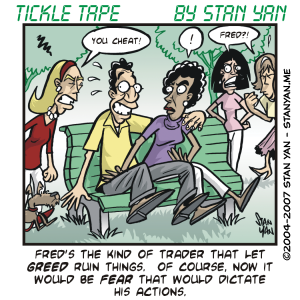Market decisions are often driven by fear and greed, especially for the novice trader. When your money is on the line, it’s natural to feel fearful when the market goes against you. Anything you can do to prevent your initial worries from escalating into debilitating fright will help you stay objective and rational. Just as a tightrope walker feels a sense of security by using a safety net, you should take specific steps to protect your financial assets. The two best ways to protect your financial interests are with a detailed trading plan and risk controls.
When it comes to risk control, a few old adages seem particularly appropriate: “Trade with money you can afford to lose. Trade positions that are so small that you may think, ‘What’s the point of even putting on the trade.'” The basic message is that if you can somehow minimize the personal significance of a trade, you will be better able to control your emotions. Since you have a less psychological stake on the line, you have almost nothing to lose. You may not need to follow these old adages verbatim, but you can follow the basic message.
Make sure that you limit your risk as much as possible. If you lose big on a single trade, it will take many more trades to build your capital back up to the previous level. It’s vital for survival to limit the amount of capital you risk on a single trade. It’s also essential to learn to cut your losses short. Don’t get stuck in a losing trade. Don’t hope that it will turn around; just sell the loser quickly. Controlling risk will not only make you feel safe and secure, but it will also ensure your longevity as well.
It’s also important to have a detailed trading plan. Before you execute a trade, specify precisely how and when you will enter, the signals that indicate the market may be going against your trade, and how and when you will exit. Many novice traders don’t carefully plan their trades. They impulsively execute a trade and then think they can develop the plan as they go along.
What usually happens is that they panic easily because they don’t know what to do and when to do it. It’s hard to think on your feet, especially when you are first learning to trade. One needs a safety net, and that safety net is a detailed trading plan to follow. The more clearly the plan is laid out, the easier it is to follow. And when the plan is easy to follow, it’s likely that you’ll stick with it. You’ll be disciplined and in control of your emotions and thought processes.
There’s no need to be a daredevil. Don’t be ashamed to use a safety net while trading. Control your risk and follow a detailed trading plan. If you follow these guidelines, you’ll achieve the long-term profitability you deserve.


